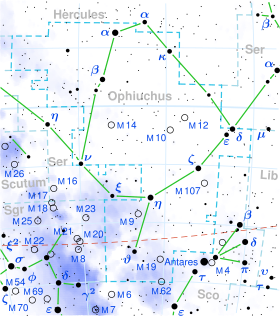| Observation data Epoch J2000 Equinox J2000 | |
|---|---|
| Constellation | Ophiuchus |
| Right ascension | 17h 21m 00.37452s[1] |
| Declination | −21° 06′ 46.5710″[1] |
| Apparent magnitude (V) | 4.39[2] |
| Characteristics | |
| Spectral type | F2V[3] |
| U−B color index | -0.06[4] |
| B−V color index | +0.41[4] |
| Astrometry | |
| Radial velocity (Rv) | −8.73±0.12[1] km/s |
| Proper motion (μ) | RA: +265.543 mas/yr[1] Dec.: -202.584 mas/yr[1] |
| Parallax (π) | 57.0820 ± 0.1851 mas[1] |
| Distance | 57.1 ± 0.2 ly (17.52 ± 0.06 pc) |
| Absolute magnitude (MV) | 3.19[2] |
| Details[5] | |
| A | |
| Mass | 1.30 M☉ |
| Radius | 1.59±0.06 R☉ |
| Luminosity | 4.429±0.035[6] L☉ |
| Surface gravity (log g) | 4.15±0.10 cgs |
| Temperature | 6,611±80 K |
| Metallicity [Fe/H] | −0.27±0.07 dex |
| Rotational velocity (v sin i) | 20.2±0.7 km/s |
| Age | 916[7] Myr |
| Other designations | |
| Database references | |
| SIMBAD | data |
ξ Oph, Latinized as Xi Ophiuchi, is a visual binary star[9] system in the equatorial constellation of Ophiuchus.[2] It has a yellow-white hue and is faintly visible to the naked eye with a combined apparent visual magnitude of 4.39.[2] The system is located approximately 57.1 light-years (17.5 parsecs) away from the Sun based on parallax, but is drifting closer with a radial velocity of -9 km/s.[1]
The magnitude 4.40[10] primary, designated component A, is an ordinary F-type main-sequence star with a stellar classification of F2V.[3] It is 916[7] million years old and is rotating with a projected rotational velocity of 20 km/s. The star has 1.3 times the mass of the Sun and 1.6 times the Sun's radius.[5] It is radiating 4.4[6] times the luminosity of the Sun from its photosphere at an effective temperature of 6,611 K.[5]
The system is a source of X-ray emission.[11] The orbiting companion, component B, is a magnitude 8.9 star at an angular separation of 35″ along a position angle of 27° from the primary, as of 2015. A magnitude 10.8 visual companion, component C, lies at a separation of 10.8″, as of 2004.[10]
According to Richard H. Allen's Star Names: Their Lore and Meaning (1899), ξ Oph together with θ Oph formed the Sogdian Wajrik "the Magician", the Khorasmian Markhashik "the Serpent-bitten" and with η Oph the Coptic Tshiō, "the Snake", and Aggia, "the Magician".[12]
- ^ a b c d e f Cite error: The named reference
GaiaDR3was invoked but never defined (see the help page). - ^ a b c d Cite error: The named reference
XHIPwas invoked but never defined (see the help page). - ^ a b Cite error: The named reference
Gray2006was invoked but never defined (see the help page). - ^ a b Cite error: The named reference
Mallama2014was invoked but never defined (see the help page). - ^ a b c Cite error: The named reference
Fuhrmann2017was invoked but never defined (see the help page). - ^ a b Cite error: The named reference
GaiaDR2was invoked but never defined (see the help page). - ^ a b Cite error: The named reference
David2015was invoked but never defined (see the help page). - ^ Cite error: The named reference
SIMBADwas invoked but never defined (see the help page). - ^ Cite error: The named reference
Eggleton2008was invoked but never defined (see the help page). - ^ a b Cite error: The named reference
WDSwas invoked but never defined (see the help page). - ^ Cite error: The named reference
Haakonsen2009was invoked but never defined (see the help page). - ^ Cite error: The named reference
allen1899was invoked but never defined (see the help page).
